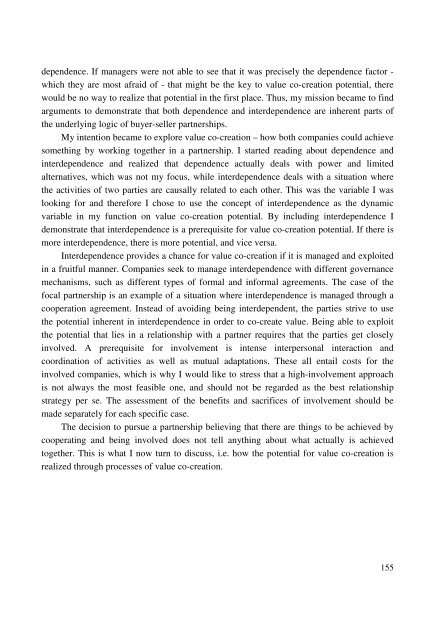Value Co-Creation in Industrial Buyer-Seller Partnerships ... - Doria
Value Co-Creation in Industrial Buyer-Seller Partnerships ... - Doria
Value Co-Creation in Industrial Buyer-Seller Partnerships ... - Doria
- No tags were found...
You also want an ePaper? Increase the reach of your titles
YUMPU automatically turns print PDFs into web optimized ePapers that Google loves.
dependence. If managers were not able to see that it was precisely the dependence factor -which they are most afraid of - that might be the key to value co-creation potential, therewould be no way to realize that potential <strong>in</strong> the first place. Thus, my mission became to f<strong>in</strong>darguments to demonstrate that both dependence and <strong>in</strong>terdependence are <strong>in</strong>herent parts ofthe underly<strong>in</strong>g logic of buyer-seller partnerships.My <strong>in</strong>tention became to explore value co-creation – how both companies could achievesometh<strong>in</strong>g by work<strong>in</strong>g together <strong>in</strong> a partnership. I started read<strong>in</strong>g about dependence and<strong>in</strong>terdependence and realized that dependence actually deals with power and limitedalternatives, which was not my focus, while <strong>in</strong>terdependence deals with a situation wherethe activities of two parties are causally related to each other. This was the variable I waslook<strong>in</strong>g for and therefore I chose to use the concept of <strong>in</strong>terdependence as the dynamicvariable <strong>in</strong> my function on value co-creation potential. By <strong>in</strong>clud<strong>in</strong>g <strong>in</strong>terdependence Idemonstrate that <strong>in</strong>terdependence is a prerequisite for value co-creation potential. If there ismore <strong>in</strong>terdependence, there is more potential, and vice versa.Interdependence provides a chance for value co-creation if it is managed and exploited<strong>in</strong> a fruitful manner. <strong>Co</strong>mpanies seek to manage <strong>in</strong>terdependence with different governancemechanisms, such as different types of formal and <strong>in</strong>formal agreements. The case of thefocal partnership is an example of a situation where <strong>in</strong>terdependence is managed through acooperation agreement. Instead of avoid<strong>in</strong>g be<strong>in</strong>g <strong>in</strong>terdependent, the parties strive to usethe potential <strong>in</strong>herent <strong>in</strong> <strong>in</strong>terdependence <strong>in</strong> order to co-create value. Be<strong>in</strong>g able to exploitthe potential that lies <strong>in</strong> a relationship with a partner requires that the parties get closely<strong>in</strong>volved. A prerequisite for <strong>in</strong>volvement is <strong>in</strong>tense <strong>in</strong>terpersonal <strong>in</strong>teraction andcoord<strong>in</strong>ation of activities as well as mutual adaptations. These all entail costs for the<strong>in</strong>volved companies, which is why I would like to stress that a high-<strong>in</strong>volvement approachis not always the most feasible one, and should not be regarded as the best relationshipstrategy per se. The assessment of the benefits and sacrifices of <strong>in</strong>volvement should bemade separately for each specific case.The decision to pursue a partnership believ<strong>in</strong>g that there are th<strong>in</strong>gs to be achieved bycooperat<strong>in</strong>g and be<strong>in</strong>g <strong>in</strong>volved does not tell anyth<strong>in</strong>g about what actually is achievedtogether. This is what I now turn to discuss, i.e. how the potential for value co-creation isrealized through processes of value co-creation.155
















